Downtown Detroit facts for kids
Quick facts for kids
Downtown Detroit
|
|
|---|---|
|
Central business district and residential area
|
|
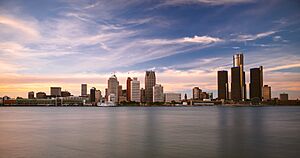
Downtown Detroit's skyline, as seen from Windsor, Ontario, Canada in September 2015
|
|
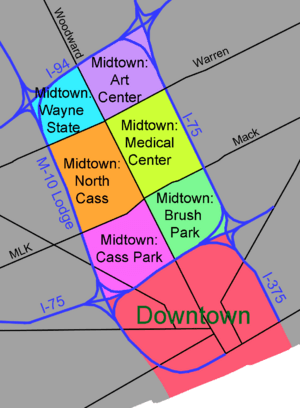
Location of Downtown in relation to Midtown
|
|
| Country | |
| State | |
| County | |
| City | |
| Area | |
| • Total | 1.4 sq mi (3.6 km2) |
| Population
(2020)
|
|
| • Total | 6,151 |
| • Density | 4,271.5/sq mi (1,649.2/km2) |
| Time zone | UTC-5 (EST) |
| • Summer (DST) | UTC-4 (EDT) |
| ZIP code(s) |
48201, 48207, 48226, 48243
|
| Area code(s) | 313 |
Downtown Detroit is the main business and living area of Detroit, Michigan, in the United States. It's often called the city's "heart." This area is about 1.4 square miles. It is surrounded by major roads like M-10, I-75, and I-375, and the Detroit River to the south.
Sometimes, "Downtown" can also mean a larger area of 7.2 square miles. This bigger area includes nearby neighborhoods like Midtown, Corktown, and Rivertown.
The main street, Woodward Avenue, connects Downtown to other important parts of Detroit. Downtown Detroit is famous for its many historic buildings and tall skyscrapers. These include the Renaissance Center and the Guardian Building. You can also find old churches, theaters, and parks, especially along the International Riverfront. The central gathering spot is Campus Martius Park.
Contents
- History of Downtown Detroit
- How Downtown Detroit Changed
- Main Areas of Downtown Detroit
- People Living in Downtown Detroit
- Getting Around Downtown Detroit
- Businesses in Downtown Detroit
- Media in Downtown Detroit
- Fun and Entertainment
- Education in Downtown Detroit
- Diplomatic Offices
- See also
- Images for kids
History of Downtown Detroit
After a big fire in 1805, the city of Detroit was redesigned. Augustus B. Woodward suggested a new layout where main streets would spread out like spokes from a wheel. This design is still somewhat visible today.
Detroit grew a lot because of the car industry. This led to more people and wealth in Downtown. Many of the beautiful buildings you see today were built during this time, in the late 1800s and early 1900s. Some buildings were designed by the famous architect Minoru Yamasaki. He also designed the original Twin Towers in New York City.
An area where Interstate 375 now stands was once home to important African American communities called Black Bottom and Paradise Valley. Black Bottom was named by French settlers because of its rich soil. Paradise Valley was a lively area with businesses and entertainment. Famous jazz artists like Duke Ellington and Louis Armstrong performed there. Sadly, these neighborhoods were removed to build the highway.
How Downtown Detroit Changed
Downtown Detroit used to have many empty buildings and not much activity. But in recent years, it has grown a lot and seen many new projects.
Since 2000, several big construction projects have finished. These include the Compuware Headquarters and two new sports stadiums: Comerica Park and Ford Field. General Motors moved its main office to the Renaissance Center. The Detroit Lions football team also moved to Downtown Detroit.
Big events like the 2005 MLB All-Star Game and Super Bowl XL have been held downtown. These events brought money to local businesses and encouraged more growth. Many new apartments and lofts have opened, attracting new residents. For example, the historic Westin Book-Cadillac Hotel was redeveloped into a hotel and condos. DTE Energy Headquarters now has parks and walkways.
In 2007, CNN Money Magazine said Downtown Detroit was one of the best big-city neighborhoods for retirement. Downtown has popular places like the International Riverfront and casinos such as MGM Grand Detroit and Greektown Casino Hotel. Many sites are also listed on the National Register of Historic Places.
Downtown Detroit has over 92,000 workers and about 6,200 residents. It offers many tall apartment buildings for people to live in. Major companies like General Motors and Compuware have their main offices here. Quicken Loans also moved its headquarters and many employees downtown in 2011.
In the late 2010s, more businesses like Shinola and Google opened stores downtown. New bike lanes, the Little Caesars Arena, and the QLine streetcar have also helped bring new people to the city. This growth has led to discussions about how the area is changing.
New construction projects are still happening. In 2021, a tall tower and another building with apartments, a hotel, offices, and shops were being built. New residential towers and a new headquarters for Huntington Bank were also under construction. Plans were also announced for a new University of Michigan campus downtown.
Main Areas of Downtown Detroit
Downtown Detroit is made up of several interesting districts, each with its own unique feel and history.
| Name | Image | Summary |
|---|---|---|
| Bricktown Historic District | 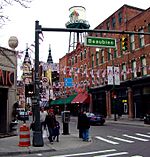 |
This area is between the Renaissance Center and Greektown. It's home to St. Peter and Paul's Catholic Church, Detroit's oldest church. You can also find the beautiful Wayne County Building here. Bricktown is known for its live music venues, including Jacoby's German Biergarten (the city's oldest pub) and St. Andrew's Hall. |
| Broadway Avenue Historic District |  |
This district has eleven commercial buildings built between 1896 and 1926. It was once a shopping area for women, with hairdressers and clothing stores. |
| Campus Martius Park |  |
Campus Martius is a central gathering place with parks, a fountain, and a monument. It's surrounded by tall commercial and residential buildings. It has become a popular spot for events and concerts. |
| Capitol Park Historic District | Capitol Park is a triangular public park. A courthouse here became Michigan's state capitol in 1837. The district includes the park and many surrounding historic buildings. | |
| Detroit Financial District |  |
This is Detroit's historic financial area, dating back to the 1850s. It has many impressive skyscrapers like the Guardian Building and the Penobscot Building. These buildings show two periods of major growth in the city. |
| Grand Circus Park Historic District | 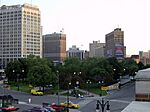 |
This district includes the 5-acre Grand Circus Park, which is split by Woodward Avenue. Important buildings around the park include the David Broderick Tower, Comerica Park, and the Fox Theatre. Many historic churches are also nearby. |
| Greektown Historic District | 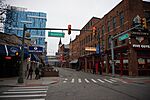 |
Greektown is a lively area with many restaurants and Greek-themed shops. It also includes Greektown Casino Hotel and historic churches like St. Mary Roman Catholic Church. |
| East Jefferson Avenue | 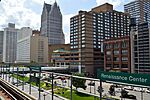 |
This street runs along the International Riverfront. It features the Renaissance Center, residential buildings, and a promenade of parks. The University of Detroit Mercy College of Law is also here. |
| West Jefferson Avenue | 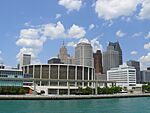 |
This street runs west from Woodward Avenue, passing under TCF Center. It continues along the Detroit International Riverfront towards the Ambassador Bridge. |
| Lower Woodward Avenue Historic District | 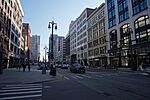 |
This district has 34 commercial buildings built in the late 1800s and early 1900s. It was once the main shopping area downtown. |
| Monroe Avenue Commercial Buildings | 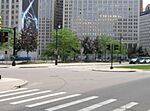 |
This area includes the National Theatre (1911), which is the oldest surviving theatre in Detroit. It was designed by Albert Kahn. |
| Park Avenue Historic District |  |
In the 1920s, this area was planned to have high-quality commercial spaces and fancy residential buildings. It includes the Detroit Women's City Club and the Kales Building. |
| Randolph Street Commercial Buildings Historic District | 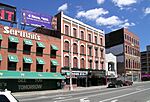 |
Buildings on Randolph Street have been used for shops since the 1840s. As Detroit grew, larger commercial buildings were built here. |
| Washington Boulevard Historic District |  |
This district features important buildings like the Book-Cadillac Hotel and the Book Tower. In the early 1900s, the street was made wider and decorated to look like famous European boulevards. |
People Living in Downtown Detroit
| Historical population | |||
|---|---|---|---|
| Census | Pop. | %± | |
| 1990 | 5,990 | — | |
| 2000 | 6,141 | 2.5% | |
| 2010 | 5,287 | −13.9% | |
| 2020 | 6,151 | 16.3% | |
In 2020, about 6,151 people lived in Downtown Detroit. The population density was about 4,271 people per square mile. There were 5,323 homes. The census showed that the residents were 54.2% White, 30.4% Black, 6.4% Asian, and other groups. About 6.5% of the population was Hispanic or Latino.
The number of people living full-time in Downtown Detroit was low in 2011. However, it grew by about 15 percent between 2012 and 2016 due to new construction.
Getting Around Downtown Detroit
Downtown Detroit has good transportation options. The main bus station, Rosa Parks Transit Center, opened in 2009. It's a central spot for bus routes.
The Detroit People Mover is an automated train system. It runs on a 2.94-mile loop through the downtown area. It's a quick way to get around.
In 2014, construction started on the M-1 Rail Line, also known as the QLine. It opened in 2017 and runs 3.3 miles along Woodward Avenue, connecting Downtown to other areas like New Center.
Businesses in Downtown Detroit
Many companies have their main offices in Downtown Detroit. These include Compuware, General Motors, Little Caesars, and Quicken Loans.
In 2014, Fifth Third Bank announced it would move its Michigan headquarters to downtown Detroit. This brought 150 employees to the city.
Previously, Comerica Bank had its headquarters in Downtown Detroit, but it moved to Dallas in 2007.
Media in Downtown Detroit
The main offices for Detroit's two biggest newspapers, The Detroit News and the Detroit Free Press, are located in Downtown Detroit.
The studio for WDIV-TV (Detroit's NBC TV station) is also downtown. It's the only TV station in the Detroit area with its studios actually in the city.
Fun and Entertainment
Downtown Detroit has seen a lot of growth in entertainment in recent years. Campus Martius Park is a popular spot year-round. In winter, you can go ice skating and see a huge Christmas tree. In summer, there's a large fountain and many concerts.
New shops have opened, like Michigan-based Moosejaw outdoor clothing. In 2012, the country's largest Buffalo Wild Wings restaurant opened downtown. A new parking garage called The Z opened in 2014. It has 1,300 parking spaces, cool artwork, and shops at street level.
Other fun places and attractions in Downtown Detroit include Philip A. Hart Plaza, the Detroit Riverwalk, the Fox Theatre, Ford Field, Little Caesars Arena, and Comerica Park.
Education in Downtown Detroit
Colleges and Universities
The University of Detroit Mercy School of Law is located downtown, across from the Renaissance Center. Wayne County Community College District (WCCCD) has its main office and a campus downtown. Wayne State University is located nearby in Midtown Detroit.
Schools for Kids
As of 2016, Downtown Detroit has several charter schools and high schools. This area has more schools for high school students compared to other parts of Detroit. Students living downtown who attend public schools are usually zoned for Martin Luther King High School.
The Archdiocese of Detroit also has several Catholic schools in the city.
Libraries
The Detroit Public Library operates the Rose and Robert Skillman Branch Library downtown. The main library headquarters is in Midtown. The downtown branch first opened in 1932.
Diplomatic Offices
Several countries have their consulates (offices that help their citizens and promote their country) in the Renaissance Center. These include the Consulate-General of Japan, the Consulate-General of Canada, and the Consulate of Italy. The Consulate of Mexico is located in the Penobscot Building.
See also
 In Spanish: Downtown Detroit para niños
In Spanish: Downtown Detroit para niños
Images for kids
-
Downtown Detroit seen from Windsor, Ontario in November 2021



